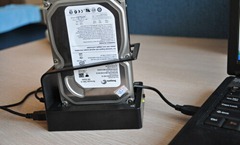How do I clone my drive so that the new drive works 100% exactly like the old one?
I have never learned anything on the HDD besides using it. Some people say I have to reinstall windows if I disk clone, some people say it’ll work exactly like my old HDD. Can anyone explain in detail how to clone?
 Backing up your data is a great way to safeguard against potential hardware failure. Cloning a hard drive creates an identical copy of everything on that drive. With a cloned hard drive you can restore your computer to its previous state or build a new computer with a setup identical to your existing one. Windows 8 has a backup and restoration tool called, strangely enough, Windows 7 File Recovery, that is designed for this purpose.
Backing up your data is a great way to safeguard against potential hardware failure. Cloning a hard drive creates an identical copy of everything on that drive. With a cloned hard drive you can restore your computer to its previous state or build a new computer with a setup identical to your existing one. Windows 8 has a backup and restoration tool called, strangely enough, Windows 7 File Recovery, that is designed for this purpose.
Hard Drive Clone Instructions
1 Press “Windows-W” on your keyboard to load the Search Settings pane. Enter “Windows 7 File” without quotation marks in the Search box.
2 Click “Windows 7 File Recovery” in the search results to load the Windows 7 File Recovery screen.
3. Click “Create a system image.”
4 Select where you want to save your hard drive clone data. Options include another hard drive, USB key, DVD or a network location.
If you want to save to another hard drive or USB key, click the “On a hard disk” radio button, click the associated pull-down menu and select your drive or USB key. If you want to save to DVD, click the “On one or more DVDs” radio button and select the name of the DVD burner you want to use. If you want to save to a network location, click the “On a network location,” click the “Select” button, and then browse to the location where you want to create the hard drive clone.
5 Click “Next” to apply your settings and initiate the cloning process.
Tips: Information in this article applies to computers running the Windows 8 operating system. It may vary slightly or significantly with other versions or products.
The Problems With Hard Drive Clone
Cloning a hard drive may present some problems for the novice computer user. The task involves advanced skills and may require extra hardware.
Programs for Cloning Vary in Quality
You can find cloning software that is free, but many of the programs can be confusing or require previous knowledge. The most user-friendly programs are expensive.
Copy Area in Use
Copying files is normally done by the operating system of your hard drive. In order to copy your hard drive, you must copy areas that would normally be in use during the copy process. To get around this you will need a bootable disc and a device to run it.
Attaching Devices for Copying
You will need to know how to hook up an additional hard drive to your device. Towers have room to install a second drive. Laptops and some desktops have limited internal space, and may require the use of an external hard drive.
Copyright and Cloning
You may not have the right to copy everything that is on your hard drive. Cloning makes a pixel-by-pixel image of your files, and does not differentiate between what is legal to copy and what is not. You will need to develop strategies to avoid accidental copyright infringement.
Backing up your entire drive: Cloning vs. imaging
Both cloning and imaging create an exact record of your drive or partition. I’m not just talking about the files, but the master boot record, allocation table, and everything else needed to boot and run your operating system.
This isn’t necessary for protecting your data–a simple file backup will handle that job just fine. But should your hard drive crash or Windows become hopelessly corrupt, a clone or image backup can quickly get you back to work.
When you clone a drive, you copy everything on it onto another drive, so that the two are effectively identical. Normally, you would clone to an internal drive made external via a SATA/USB adapter or enclosure.
But imaging a drive is more like creating a great big .zip file (without the .zip extension). Image backup software copies everything on the drive into a single, compressed, but still very large file. You would probably save the image onto an external hard drive.
So what are the advantages of each?
Should your primary hard drive crash, a clone will get you up and running quickly. All you have to do is swap the drives.
On the other hand, if your drive crashes and you’ve backed it up to an image, you’d have to buy and install a new internal hard drive, boot from your backup program’s emergency boot disc, and restore the drive’s contents from the backup.
So why image? An image backup provides greater versatility when backing up. You can save several images onto one sufficiently large external hard drive, making it easier and more economical to save multiple versions of the same disk or back up multiple computers.
You can find several programs that can do these chores, including the backup tools in Windows 7 and 8. But I recommend Macrium Reflect Free, which is free for personal use. It’s easy to use, can clone and image, and in my experience, is extremely reliable.

